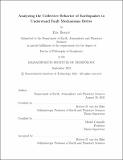Analyzing the Collective Behavior of Earthquakes to Understand Fault Mechanisms Better
Author(s)
Beaucé, Eric
DownloadThesis PDF (36.53Mb)
Advisor
van der Hilst, Robert D.
Campillo, Michel
Terms of use
Metadata
Show full item recordAbstract
The Gutenberg-Richter law tells us that there is a tenfold increase in the number of earthquakes of magnitude 𝑚 > 𝑀 when 𝑀 decreases by one unit. Thus, the vast majority of earthquakes occur at magnitudes so small that the vibrations they cause can barely be recorded at the surface of Earth. Given that earthquakes are the symptoms of motion on faults, observing small earthquakes brings valuable information on fault mechanisms. In this thesis, not only do I focus on studying small-to-moderate size earthquakes (M < 4), but I study properties that emerge when many of these earthquakes interact. Many of my conclusions are drawn from observations of earthquake temporal clustering.
I present the automatic earthquake detection and location method that I developed for collecting the time and space coordinates of as many earthquakes as possible, and base all subsequent analyses on these. My investigations covered two study regions: the Southwestern Alps, and the western section of the North Anatolian Fault that last broke in August 1999. In both studies, I demonstrate how different fault systems produce seismicity with different temporal clustering properties. Observations of temporal clustering describe seismicity patterns between two end-members: the swarm-like seismicity with little inter-event triggering, and the cascade-like seismicity with strong earthquake interaction.
Temporal clustering and the analysis of earthquake source characteristics in the Southwestern Alps helped explain differences in fault mechanisms in the two most active areas of the study region. My results also point towards non self-similar earthquakes. Along the North Anatolian Fault, in addition to temporal clustering, I analyzed the earthquake focal mechanisms, used them to infer the state of stress in the fault zone, and thus provided a comprehensive description of the study region. A major conclusion of this study is that strongly time clustered seismicity developed in normal fault systems several years after the 1999 Izmit earthquake, and may indicate the inter-play between seismic and aseismic slip on these faults.
Date issued
2021-09Department
Massachusetts Institute of Technology. Department of Earth, Atmospheric, and Planetary SciencesPublisher
Massachusetts Institute of Technology